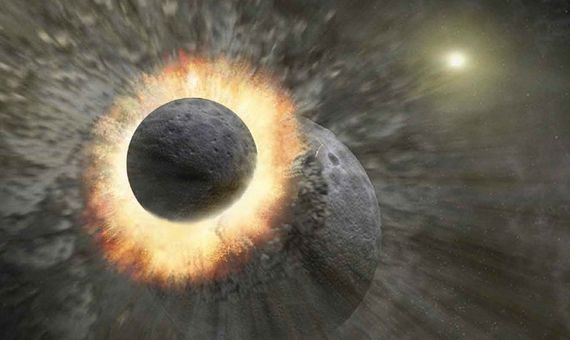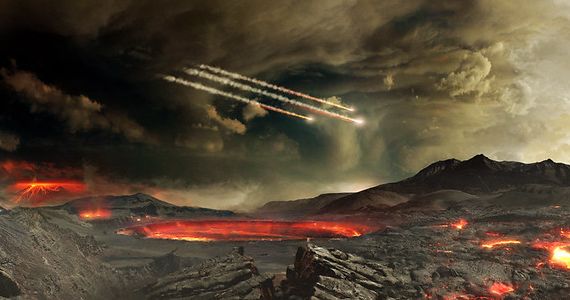We tend to accept that it is natural for humans to inhabit the cosmos. We ask ourselves how it could be otherwise. What would be the point of the universe if it had not allowed us to exist? This misinterpretation of the so-called anthropic principle, which according to astrophysicist and populariser Ethan Siegel is “the most abused idea in science“, often leads to a corollary: if we are here, why not many, many millions of others? Another principle, that of mediocrity, suggests that there is nothing special about our galaxy or Earth. And yet, so far, not only are we unaware of the existence of anyone else, but we have yet to find a planet similar to our own. Life is far from inevitable, say scientists, and our presence here may simply be the result of a series of lucky events, like prizes from a cosmic lottery that many other planets missed out on at some point in their history.
The existence of life on Earth rests on five main pillars: the distance from the Sun, neither too close nor too far away, just enough for liquid water; the magnetic core, which protects the atmosphere from the drag of the solar wind and life from cosmic radiation; the atmosphere itself, whose greenhouse effect prevents water from freezing; water, naturally, the universal solvent of life; and finally oxygen, which allows us to breathe.
But unlike a recipe, these ingredients are not entirely independent of each other. And, above all, as in the preparation of any dish, only if they are combined in the right order and cooked in the correct way do we obtain the result that makes it possible for us to be here today.
A great collision as the origin of our planet
About 4.568 billion years ago, in a corner of a galaxy, a cloud of gas and dust created a new star surrounded by a protoplanetary disc, whose material began to clump together in ever-increasing masses. In just a few million years, the Solar System looked much like it does today, but between Venus and Mars there was not one planet, but two; according to the most widely accepted hypothesis, the subsequent collision between the Proto-Earth and Theia, another Mars-sized object, gave rise to our Earth and its Moon some 4.51 billion years ago. These figures are obtained by studying the isotope ratios of elements such as lead, which is produced by the radioactive decay of uranium over billions of years.

By pure chance, this new planet, still incandescent, was within that band that scientists call the Goldilocks zone, like the “just right” bowl of porridge in the fairy tale: far enough away from the Sun that it would not freeze when it cooled, such that liquid water could exist. In turn, this also depended on the planet’s mass and, related to this, on its atmosphere being thick and dense enough to generate a greenhouse effect, albeit not a powerful one; Venus is the go-to example of how too intense a greenhouse effect can turn a planet into a scorched hell.
What’s more, the persistence of this atmosphere was supported by a magnetic field created by a planetary core of molten metal in motion, acting like an enormous dynamo. Our other neighbour, Mars, is an example of how the lack of a magnetic shield to protect the planet from the buffeting of the solar wind, which the little red planet lost as its core cooled, eventually stripped it of its atmosphere.
Water, the origin of terrestrial life
But for all this to progress, the presence of water is essential. It has traditionally been proposed that the fiery early Earth was a dry ball and that water arrived on board the meteorites and comets that fell on the planet in its early days. However, a recent study suggests that, despite the contribution of these possible impacts, much of the Earth’s water may have actually formed from the hydrogen and oxygen present in very building blocks of the planet itself.

Thus, about 4.4 billion years ago we had a nearly habitable Earth, covered by a global ocean. But according to the traditional idea, 3.9 billion years ago an intense asteroid bombardment —the so-called Late Heavy Bombardment—would have sterilised all early attempts at life. Although this hypothesis has recently been challenged, the evidence indicates that the cooling of the Earth was rapid; by 3.4 billion years ago, the waters had reached a comfortable temperature of about 40°C. Geological evidence indicates that terrestrial microbes were already present some 3.8 billion years ago, but perhaps the earliest living things can be traced back even further, almost to the very origin of the oceans, before the great bombardment.
Oxygen: the poison before the antidote
The emergence and evolution of early life is a field in which science will have to make further progress, as the clues are still incomplete. The first single-celled organisms lived in an unbreathable atmosphere, composed of gases such as methane and ammonia. Around 2.4 billion years ago, the so-called Great Oxidation Event took place, when the atmosphere began to be populated by oxygen in its breathable molecular form, which is attributed to the emergence of photosynthetic cyanobacteria. However, a comparative molecular analysis concludes that these appeared after the Great Oxidation, leaving the emergence of breathable oxygen to other, even more primitive microbes.
However, what made the emergence of complex life possible was at the same time the cause of the first great terrestrial extinction, as oxygen was a poison to other early living things. In turn, the reaction of oxygen with methane consumed this potent greenhouse gas and produced water and carbon dioxide, leading to a brutal change in climate that enveloped the Earth in ice for 300 million years.
Oxygen was thus the first major cause of extinction on Earth, but at the same time it was the engine of life, a turning point in the course of evolution that would give rise to multicellular beings and the explosion of life as we know it today, enormously diverse and complex, a cosmic lottery in which, at least as far as we know, only a first prize has been awarded.
Comments on this publication